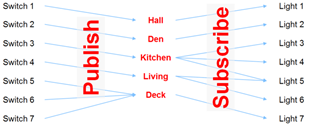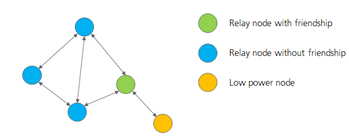 In December 2016, the Bluetooth consortium (Bluetooth Special Interest Group, SIG) rolled out Bluetooth 5, the latest version of the Bluetooth core specification. This 5th revision, which I present here, includes a number of groundbreaking enhancements.
In December 2016, the Bluetooth consortium (Bluetooth Special Interest Group, SIG) rolled out Bluetooth 5, the latest version of the Bluetooth core specification. This 5th revision, which I present here, includes a number of groundbreaking enhancements.
In addition to the Bluetooth 5 specification, the consortium released the specification for Bluetooth mesh in June 2017. Bluetooth mesh is a software enhancement that can run on any Bluetooth low energy solution; it does not require Bluetooth 5.
In my opinion, the features provided by Bluetooth 5 and Bluetooth mesh are the most substantial enhancements to Bluetooth technology since its introduction in 1998. They will enable a whole host of new use cases, some which are of specifically relevant to Industrial IoT applications.
Bluetooth 5
Bluetooth 5 provides three main feature improvements compared to the preceding release:
• twice the data rate – from 1 Mbps to 2 Mbps
• four times the range
• eight times the advertising packet size (beacons)
Let’s take a closer look at each of these three new features.
Increased data rate
The 2 Mbps physical rate (PHY) doubles the amount of data that can be transmitted per second compared to the preceding revision of the specification. While sending data using Bluetooth 5 draws slightly more power than previously, transmission times are cut to half. As a result, the same amount of data can be sent with just over 50% the total power required by Bluetooth v4.2.
In addition to faster data transmission rates, shorter transmission times result in improved co-existence with other 2.4 GHz radios (including other Bluetooth low energy connections) as the radio is active for a shorter duration.

Extended range
By extending the range of Bluetooth signals, the Bluetooth SIG is seeking to extend the reach of Bluetooth low energy to cover entire homes. Two new modulation options, 125 kbps and 500 kbps, extend its range up to four-fold compared to the current Bluetooth low energy specification. In line-of-sight, the range of Bluetooth signals is expected to exceed 1 km range using the same amount of power. The Bluetooth 5 specification further increases maximum output power to 20 dBm compared to today’s 10 dBm. This enables even greater distances between Bluetooth 5 devices, of course at the cost of increased power consumption.
Home automation is obviously a key target application for the Bluetooth SIG going forward. This is clearly indicated by the fact that two new members of the Bluetooth SIG board of directors were brought in from Philips Lighting and Google Nest. Key players in the home automation industry see an interest in adopting Bluetooth low energy to connect the devices they develop.
Richer beacons
The third new feature Bluetooth 5 brings to the table is extended advertising capability. First introduced in Bluetooth low energy, advertising lets low power sensor nodes signal “I have new data” to a central unit. If the central device is interested in that data, it initiates a connection during which it exchanges data with the sensor node. Once the exchange is completed, the connection is closed and the sensor node goes back into low power mode. Short advertising messages were sufficient to enable this type of exchange.
However, it didn’t take long for device manufacturers to figure out that this kind of “non-connected” advertising message can also be used as a beacon to broadcast information without first having to establish a connection. Apple developed their way of doing it in iBeacon, and Google countered with Eddystone.
With the popularity of the beacon use case came the desire to make it more powerful and broaden its scope. Bluetooth 5 takes the beacon use case to a new level by increasing advertising message length from 31 bytes previously to 512 bytes, even allowing for multiple 512 byte messages to be linked together. To avoid congestion, it extends these longer advertising packets to all 40 available channels rather than limiting advertising to three advertising channels as in the previous specification.
Extended advertising capability lets nodes send more data packets, even packet streams, without first having to establish a Bluetooth low energy connection. Even though Bluetooth low energy was designed for low power use cases, short data packets, and quick connection establishment, establishing a Bluetooth low energy connection always consumes extra power. In some use cases, broadcasting data connection-free can push down total power consumption even further.
Advertising messages play an essential role in Bluetooth mesh, in which they are used to broadcast data to other nodes.
Bluetooth mesh
Shortly after the release of the Bluetooth 5 specification, the Bluetooth SIG released the specification for Bluetooth mesh. Together, Bluetooth 5 and Bluetooth mesh lay the foundation for many new applications and use cases. They are particularly important for the Industrial Internet of Things as they enable use cases previously only possible with other technologies such ZigBee, Sub-GHz, etc. Because the key advantages are already supported by Bluetooth, the combination of Bluetooth 5 and Bluetooth mesh is expected to enable a host of new application areas and use cases.
Bluetooth mesh is standardized by the Bluetooth SIG, which means that devices implementing it will be interoperable. Bluetooth mesh is designed around the following techniques:
• a publish-subscribe model
• managed flooding
• friendship for low power nodes


In a Bluetooth mesh network, network nodes are configured to operate in a publish-subscribe model. Information among nodes is transmitted in messages. Nodes providing data or actions use messages to publish information on the network. Other nodes can either collect the data in messages or use it for actions. Figure 2 depicts a simple mesh network made up of switches and lights and shows how they are configured to operate.
To spread a message across the mesh, the source node simply broadcasts its message using advertising. Other nodes in the network then receive and forward the message to all other nodes, extending the range of the mesh network well beyond the capability of an individual Bluetooth link. This is referred to as flooding mesh. There are several basic mechanisms in place to ensure that the network is not overloaded. Examples include (i) not relaying messages that a node has already touched, and (ii) limiting the number of hops.
For a network to support relaying, relaying nodes need to actively listen to messages all the time. This means that they cannot operate in low power mode. Nodes with limited power can instead be configured in a friendship relationship with relaying nodes. In a friendship relationship, the relaying node temporarily stores data until the low power node wakes up. Then the data is exchanged during the short period in which the low power node is active.
Industry 4.0
Industry 4.0, sometimes referred to as the Industrial Internet of Things (IIoT), is an initiative that was launched by the German government in 2011. Since then, many other regions have created their own variants of the concept: In 2015, Japanese companies formed the Industrial Value Chain Initiative (IVI). In the US, the Industrial Internet Consortium was set up to encourage greater use of the Internet in the American manufacturing sector.
In manufacturing, Industry 4.0 seeks to leverage technology to improve efficiency and reduce impact on natural resources. Examples of such enabling technologies include low power and low cost sensors, wireless connectivity, affordable network infrastructure, and computing power to analyze the large amount of collected data (Big Data).
In predictive maintenance applications, for example, sensors are added to traditional electric motors. Sensor data is then analyzed to assess their operation (temperature, vibrations etc.) and predict when maintenance becomes necessary. The objective of predictive maintenance is to prevent unexpected failures that would cause unplanned disruptions in the manufacturing process, but also to avoid unnecessary maintenance operations imposed by an overly conservative preventive maintenance schedule
Bluetooth 5 in Industry 4.0
The enhanced features provided by Bluetooth 5 pave the way for a number of new Industrial Internet of Things applications. Examples include:
• device firmware upgrades
• large industrial sensor networks, e.g. capillary networks
• asset tracking
• connected buildings
• industrial real-time control
Let’s take a closer look at some of the aforementioned use cases.

Device firmware upgrade
The increased data rate provided by Bluetooth 5 – up to 1.4 Mbps – is sufficient to quickly send small files over the Bluetooth low energy connection. This makes it possible for industrial devices running embedded firmware, such as variable frequency drives, to use a Bluetooth low energy connection to transfer firmware files for Device Firmware Upgrade Over The Air (DFU-OTA).
The latest generation of smartphones that support Bluetooth 5 may be used as mobile gateways between the internet and the industrial device.
With a data rate of 1.4 Mbps, it only takes seven seconds to send a 1 MB firmware file, which is typical in many embedded industrial products. Device manufacturers might even consider replacing Wi Fi with Bluetooth low energy for this use case, bringing down both device cost and power consumption.

Industrial IoT capillary sensor networks
In the predictive maintenance use case, sensors need to be connected to a number of otherwise unconnected devices. There are two ways to do this: Sensors can either connect directly to the cellular network, or they can connect to short range radio networks that, in turn, are connected to cellular gateways. The second approach is referred to as a capillary sensor network. Bluetooth 5 and Bluetooth mesh can be used to support capillary sensor networks by letting large numbers of sensors connect into a large network. Using Bluetooth as the short range radio has a multiple advantages over other short-range technologies. The main one is that Bluetooth is supported in almost all smartphones and tablets, making them the obvious tools for sensor and network configuration.
Asset tracking
Mesh networks set up to control lighting in a building or factory, e.g., can be used to enable additional use cases such as asset tracking. This requires configuring Bluetooth mesh enabled asset tags to connect to the same mesh network, allowing nodes in the mesh sensor network to report which asset tags they detect back to devices monitoring the network. Information gathered from several nodes in the network can then be used to determine the approximate location of each asset. The accuracy provided is sufficient to know on what floor and in which room valuable assets are located. Examples of assets that could be monitored using this approach are expensive, moveable industrial equipment and specialized tools at manufacturing sites.
References
1) Bluetooth SIG – Mesh Technology Overview
2) Ericsson – Capillary Networks – Bridging the Cellular and IoT Worlds
3) Royal Institute of Technology – Techno-economic study on capillary networks and cellular technologies for Machine-to-Machine communications






